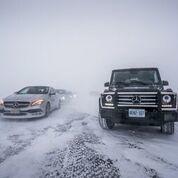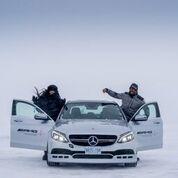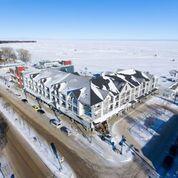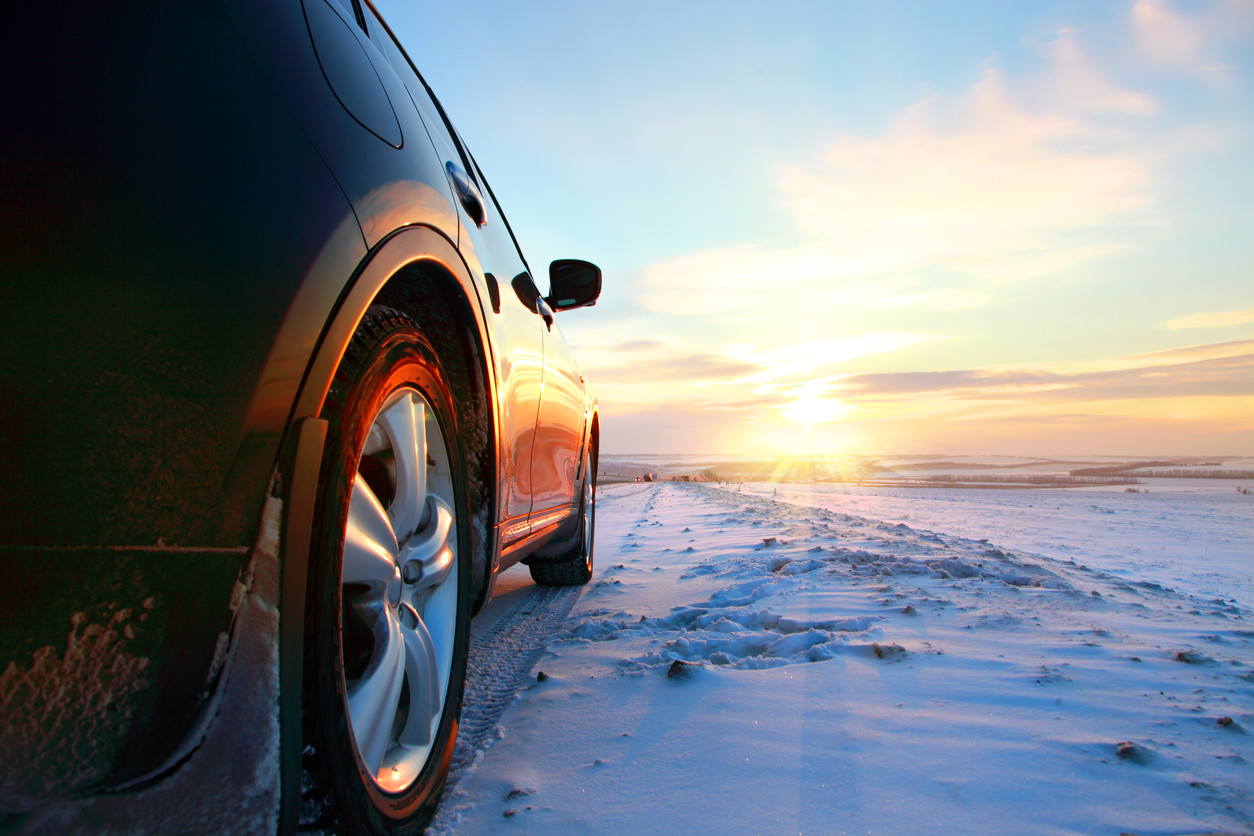Gimli, Manitoba — “As giddy as a maiden en route her bridal chamber.” my diary says, describing the pervasive excitement.
Welcome to AMG Winter Sporting, part of the AMG Driving Academy. Courtesy of Mercedes-Benz Canada, we’re here to learn drifting techniques, then race their cars on a suite of uniquely milled and professionally maintained ice tracks.
It’s probably the most fun you can have in a car while clothed.
 Ask any figure skater: The practice of drifting on ice demands a not-just-theoretical but physical understanding of how power, speed and momentum interact. Many of us will learn that instinct is brutally hard to overcome. (Then again, when you do lose control, on some level you’ve noticed where the edge and hopefully you won’t go over it next time.)
Ask any figure skater: The practice of drifting on ice demands a not-just-theoretical but physical understanding of how power, speed and momentum interact. Many of us will learn that instinct is brutally hard to overcome. (Then again, when you do lose control, on some level you’ve noticed where the edge and hopefully you won’t go over it next time.)
This two-day event is a truncated version of the 3-day thrill-fest Mercedes-Benz sells, an adrenaline-charged excuse to slide and push cars that we wouldn’t dare treat so cavalierly if we owned them.
 R&B singer Ciara and her Seattle Seahawks husband were here earlier this week with their BBG — the family shared my elevator this opening night. (Ciara was singing to the baby. It was less uncomfortable feeling than you’d think.) Of course, not every student is that rich and famous, but it’s a rarefied demographic the academy caters to.
R&B singer Ciara and her Seattle Seahawks husband were here earlier this week with their BBG — the family shared my elevator this opening night. (Ciara was singing to the baby. It was less uncomfortable feeling than you’d think.) Of course, not every student is that rich and famous, but it’s a rarefied demographic the academy caters to.
The instructors are qualified pros, not like us. If we wipe out — many of us will — we’ll slide into “snowbanks” so crusty from cold that extricating ourselves without exacting care could remove a bumper.
The lineup of vehicles we will drift in and race?
4MATIC is the Mercedes-Benz name for all-wheel drive. We’ll be driving their CLA 45 4MATIC, C 63 Sedan and E 63 4MATIC+ Sedan. The C-class is rear-wheel drive with the thrust of a thousand canons. Meanwhile, the CLA’s and E-class’s all-wheel drive systems behave quite differently in where they prefer to send power.
The result? The lessons shallowly learned during each session spent in any one vehicle are quickly dashed when the dynamics of another — albeit wonderful — sporty drive is given to us. But let’s back up a bit.
Much of the first day was spent getting to Gimli, Manitoba.
 The town was dark within an hour of our arrival. A seasonal hotspot whose economy depends largely on summer trade, Gimli’s Icelandic roots are still clearly evident (albeit beneath several layers of wooly sweaters, wicking fleeces, Timmy’s crullers, and parkas). Such seasonality makes Gimli ideal for this program. AMG Winter Sporting functionally takes over the town for 3 months.
The town was dark within an hour of our arrival. A seasonal hotspot whose economy depends largely on summer trade, Gimli’s Icelandic roots are still clearly evident (albeit beneath several layers of wooly sweaters, wicking fleeces, Timmy’s crullers, and parkas). Such seasonality makes Gimli ideal for this program. AMG Winter Sporting functionally takes over the town for 3 months.
Back to this first “day” here: I’m reluctant to say they threw us in the deep end in a place where the temperature hasn’t seen zero since early December, so that the ice is 150cm thick. (That’s almost 5 feet but German technology somehow deserves metric description.) Nonetheless we were exposed to the pre-windchill –15 degree temperatures and ice-time in all three sedans before we even had a chance to unpack and select an outfit for dinner. It was cold hard fun.
Next day begins with a briefing session that’s actually brief.
“Controlling and maintaining the drift is a matter of finding the balance in throttle maintenance and accurate steering.” Reinhold Renger and Danny Kok are the Academy’s Chief instructors. They’re a tight team, well complemented by their crew of dedicated employees, who — it’s worth mentioning — are not freelance guns-for-hire. (Danny’s son kept me out of a snowbank last night.) The instructors’ tips are useful and most of us nod, agreeing in principle with their advice.
“Has anyone here ever ridden a unicycle?” asks Renger. “Riding isn’t about strictly remaining vertical; you have a range of balance on a unicycle.” He waves his arm by and forth like a dial.
“It’s like this with drifting.”
What a brilliant analogy, we all nod.
Mind, no one in the room has ever ridden a unicycle except Renger. Which leads to one of the most important lessons at this academy: there are several types of learning. You can read about driving strategy your whole life and not really know much in media res.
Today is about kinesthetic instruction. That is tactile, hands-on learning by doing.
 Within the hour, we pile out of the hotel and into assigned cars. (The bone-chilling temperatures that even make spaces between words uncomfortable aren’t a huge problem because the hotel has the space to store the cars just steps from the doors and the ice courses are just meters from the parking lot.) We’re split into groups of four — which they call teams. We will operate in half-hour sessions and switch vehicles and courses throughout the morning.
Within the hour, we pile out of the hotel and into assigned cars. (The bone-chilling temperatures that even make spaces between words uncomfortable aren’t a huge problem because the hotel has the space to store the cars just steps from the doors and the ice courses are just meters from the parking lot.) We’re split into groups of four — which they call teams. We will operate in half-hour sessions and switch vehicles and courses throughout the morning.
Shh, it’s time for the first session. Once we’re lined up and ready to launch, we’re instructed by walkie-talkies resting in cupholders to turn off the nanny controls and switch the ride to Sport Mode and Sport Suspension.
Yes. We smile. And then? Reinhold jumps into my CLA 45’s passenger seat to provide real-time instruction.
“More throttle. More throttle!”
Renger encourages while we slide sideways in a huge oval that doesn’t quite close. I’m starting to lose control and instinctively ease back. “You’re easing back! MORE throttle!”
Education theorists talk about learning as a gradual process but everyone who works sturdily at something has at one time experienced a sudden leap to light speed where everything suddenly (and likely briefly) makes sense. Call it an epiphany. It feels good.
“More THROTTLE!” He actually pushes my leg down into the accelerator! Ahh! We drift, I gain control, remembering to look where I want to go, not necessarily where we’re going. The hands intuitively follow the eyes. My smile expands. We’re drifting yet in control. Imagine the best golf swing you’ve ever hit but in even stupider looking clothes.
Later, I apply the knowledge in the E-class.
More throttle, I hear in my head. More throttle I obey. I’m controlling an extended starboard glide while the front wheels are dragging us, man and machine in synch, towards the pylon beckoning my eyes.
“SPIN, SPIN, SPIN” an excited tenor suddenly crackles and brays over the walkie, harshing my controlled mellow.
We’ve been told to remain in constant communication. If we spin, we are to report immediately so others on the track know to slow down. I look around to see who’s spun, spun, spun, my eyes no longer on the pylon where I want to go.
![]() There’s a level of learning — call it an epiphany — that those who study any subject ascend to when they realize that, although they’d recently believed they were informed, in fact, they know squat. I have ascended there! Meaning?
There’s a level of learning — call it an epiphany — that those who study any subject ascend to when they realize that, although they’d recently believed they were informed, in fact, they know squat. I have ascended there! Meaning?
Welcome! We’re stuck atop a snowbank. “Spin, spin, spin over here too.”
I’ve never ridden a unicycle. It looks hard.
Epilogue: The day culminates in a race between leaders from the teams.
After lunch, our group of four shrinks to two because of demanding shooting schedules and content deadlines for rival organs. Consequently, my friend Matt and I enjoy interrupted sessions of ice track riding and sliding, lasting up to 30 minutes between quick vehicle switches, after which we do it again. We improve.
As for the race? A driver from our team wins. It’s Matt but, given that there were only two of us during the first heat of his challenge, I like to think I’d have beat all comers if only I’d taken him first. Especially given all I’ve learned.
By Steven Bochenek


